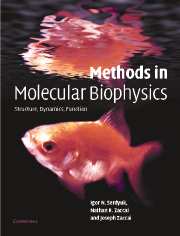Book contents
- Frontmatter
- Contents
- Foreword by D. M. Engelman
- Foreword by Pierre Joliot
- Preface
- Introduction: Molecular biophysics at the beginning of the twenty-first century: from ensemble measurements to single-molecule detection
- Part A Biological macromolecules and physical tools
- Part B Mass spectrometry
- Part C Thermodynamics
- Part D Hydrodynamics
- Part E Optical spectroscopy
- Part F Optical microscopy
- Part G X-ray and neutron diffraction
- Part H Electron diffraction
- Part I Molecular dynamics
- Part J Nuclear magnetic resonance
- References
- Index of eminent scientists
- Subject Index
Introduction: Molecular biophysics at the beginning of the twenty-first century: from ensemble measurements to single-molecule detection
Published online by Cambridge University Press: 05 November 2012
- Frontmatter
- Contents
- Foreword by D. M. Engelman
- Foreword by Pierre Joliot
- Preface
- Introduction: Molecular biophysics at the beginning of the twenty-first century: from ensemble measurements to single-molecule detection
- Part A Biological macromolecules and physical tools
- Part B Mass spectrometry
- Part C Thermodynamics
- Part D Hydrodynamics
- Part E Optical spectroscopy
- Part F Optical microscopy
- Part G X-ray and neutron diffraction
- Part H Electron diffraction
- Part I Molecular dynamics
- Part J Nuclear magnetic resonance
- References
- Index of eminent scientists
- Subject Index
Summary
The ideal biophysical method would be capable of measuring atomic positions in molecules in vivo. It would also permit visualisation of the structures that form throughout the course of conformational changes or chemical reactions, regardless of the time scale involved. At present there is no single experimental technique that can yield this information.
A brief history and perspectives
Molecular biology was born with the double-helix model for DNA, which provided a superbly elegant explanation for the storage and transmission mechanisms of genetic information (Fig. 1). The model by J. D. Watson and F. H. C. Crick and supporting fibre diffraction studies by M. H. F Wilkins, A. R. Stokes, and H. R Wilson, and R. Franklin and R. G. Gosling, published in a series of papers in the 25 April, 1953 issue of Nature, marked a major triumph of the physical approach to biology.
The Watson and Crick model was based only in part on data from X-ray fibre diffraction diagrams. The patterns, which demonstrated the presence of a helical structure of constant pitch and diameter, could not provide unequivocal proof for a more precise structural model. One of the ‘genius’ aspects of the discovery was the realisation that A–T and G–C base pairs have identical dimensions; as the rungs of the double-helix ladder, they give rise to a constant diameter and pitch.
- Type
- Chapter
- Information
- Methods in Molecular BiophysicsStructure, Dynamics, Function, pp. 1 - 18Publisher: Cambridge University PressPrint publication year: 2007

